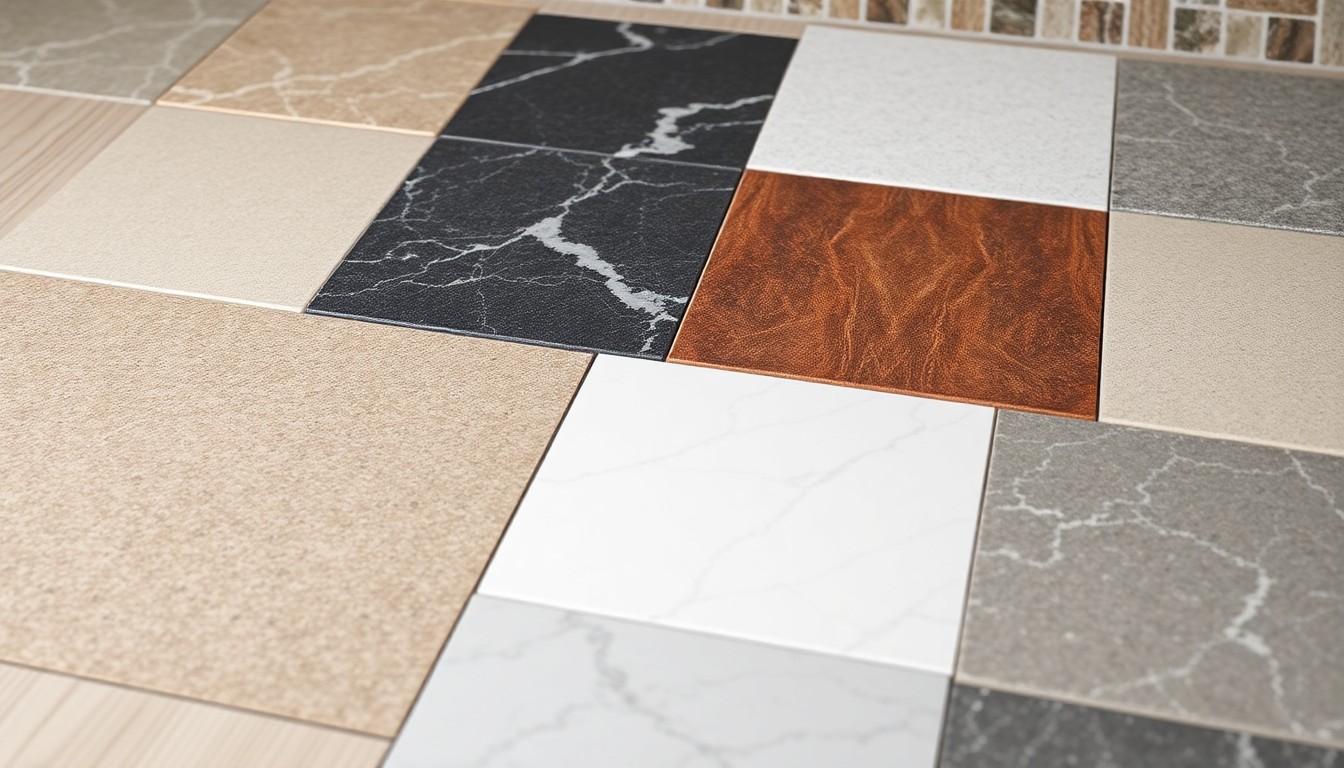The post 10 Stunning Bathroom Floor Tiles to Transform Your Space in 2025 | Expert Guide appeared first on UK Construction Blog.
Key Takeaways
- Bathroom floor tiles create a foundation for both style and practicality, offering durability while allowing personal expression through various designs and patterns
- Porcelain tiles are ideal for bathrooms with their exceptional water resistance (less than 0.5% absorption), while ceramic offers more design variety at a lower cost
- Slip resistance is a critical safety feature when selecting bathroom floor tiles – look for specific ratings (R-values or PEI ratings) and consider textured or matte finishes
- Large format tiles (600×600mm or larger) create a spacious feel with fewer grout lines, while patterned tiles and mosaics add character and visual interest
- Proper installation requires thorough surface preparation, accurate measurements, and consideration of underfloor heating compatibility for optimal results
- Regular maintenance with appropriate cleaners for your specific tile material and sealing grout every 6-12 months will significantly extend the lifespan of your bathroom flooring
Transforming your bathroom starts from the ground up, and bathroom floor tiles are the perfect foundation for creating a space that’s both stylish and practical. These versatile design elements offer incredible durability while allowing you to express your personal aesthetic, whether you’re drawn to sleek minimalist designs or bold, eye-catching patterns. With proper installation, they’re remarkably cost-effective over time, requiring little maintenance beyond regular cleaning and occasional resealing.
Looking to make a statement in your bathroom? Floor-to-wall tiling creates a seamless, luxurious look that can completely transform the room. When selecting your tiles, you’ll want to ensure they’re strong enough for floor use and feature slip-resistant ratings for safety in wet areas. With thoughtful planning and the right approach, you can achieve a professional finish that reflects your individual taste and turns your bathroom into a personal haven you’ll love using every day.
Types of Bathroom Floor Tiles
Bathroom floor tiles come in various materials, each with unique properties suited for different needs and preferences. From water-resistant options to luxurious stone finishes, selecting the right tile type transforms your bathroom while ensuring practicality in this moisture-rich environment.
Ceramic vs Porcelain Tiles
Ceramic and porcelain tiles are popular bathroom flooring choices, with distinct differences in water absorption and durability. Porcelain tiles absorb less than 0.5% of water, making them ideal for steamy shower rooms and wet areas. These dense, hard-wearing tiles withstand heavy foot traffic, perfect for busy family bathrooms. Ceramic tiles, while more water-absorbent, offer greater design variety and typically cost less than porcelain alternatives. Both options provide excellent value, but porcelain’s superior moisture resistance makes it particularly suited for bathrooms with high humidity levels. Check the slip resistance rating on your chosen tiles to ensure safety in wet conditions.
Natural Stone Options
Natural stone tiles add elegance and character to bathroom floors with their unique patterns and textures. Marble bathroom tiles create a luxurious, timeless appeal with distinctive veining patterns that make each installation unique. Other natural stone options include:
- Limestone: Offers a softer, more understated look with natural warmth
- Slate: Provides excellent slip resistance with rustic, textured surfaces
- Travertine: Features earthy tones and natural pitting for character
- Granite: Delivers exceptional durability with striking natural patterns
While natural stone requires more maintenance than manufactured tiles, including regular sealing to prevent water damage, the distinctive beauty and natural variation make it a worthwhile investment for creating a spa-like bathroom retreat.
Luxury Vinyl Tiles
Luxury vinyl click flooring offers a practical alternative to traditional hard tiles in bathrooms. These water and heat-resistant tiles withstand humid environments while providing comfort underfoot. Modern manufacturing techniques create remarkably realistic finishes that mimic natural materials, including:
- Stone effect designs with authentic textures
- Mosaic patterns for decorative interest
- Parquet wood effects for warmth without moisture concerns
Luxury vinyl tiles install easily with click-together systems, making them ideal for DIY enthusiasts. They’re also warmer to the touch than ceramic or stone, eliminating the cold-floor shock on winter mornings. Their cushioned composition provides greater comfort when standing for extended periods during grooming routines.
Water-Resistant Laminate
Water-resistant laminate flooring offers an affordable bathroom flooring solution with improved moisture protection. Unlike standard laminate, bathroom-specific versions feature enhanced core boards and sealed edges that prevent water penetration. These tiles provide convincing wood and stone effects at a fraction of the cost of natural materials. Installation typically involves a floating floor system with waterproof underlayment to create an additional moisture barrier. While not recommended for shower enclosures or areas with standing water, water-resistant laminate performs well in family bathrooms with proper care. The wide range of designs available, including grey floor tiles in various chromatic intensities, allows you to match your bathroom’s interior design scheme with minimal investment.
Key Factors When Choosing Bathroom Floor Tiles
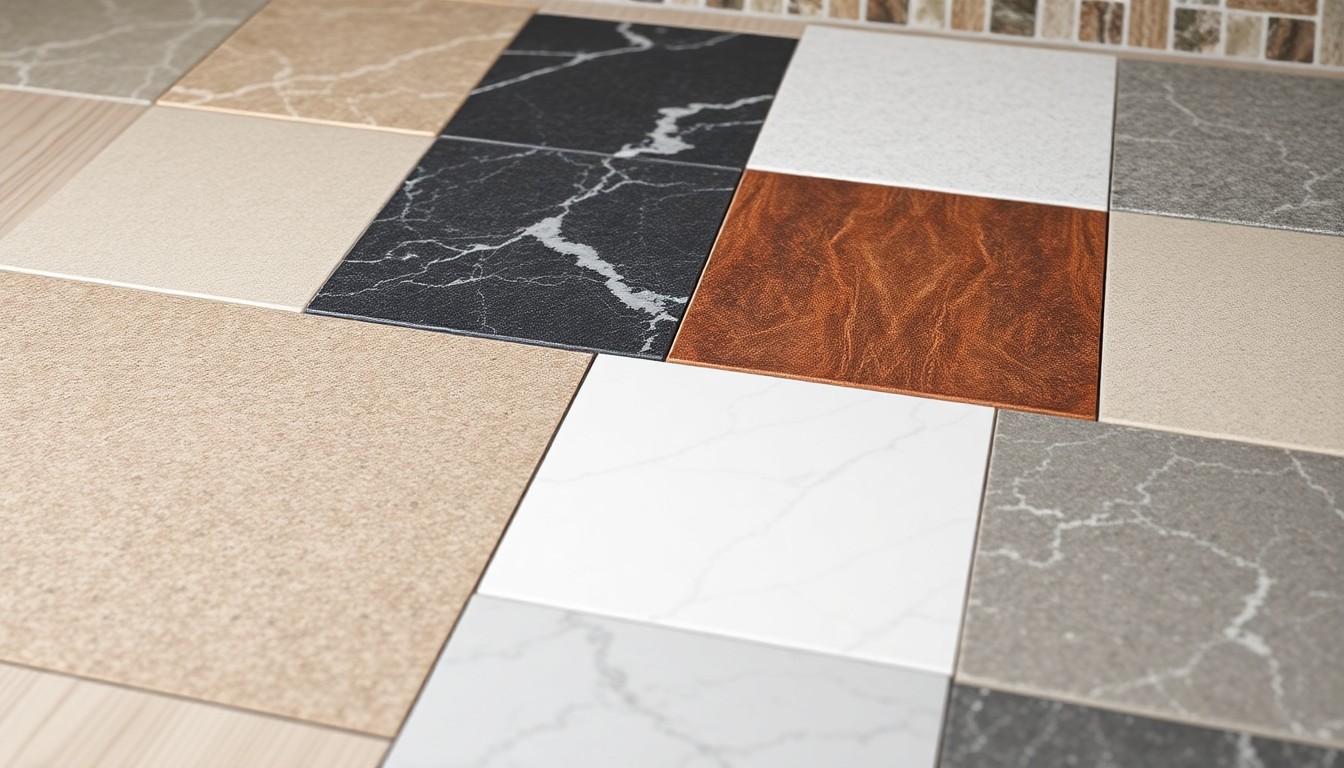
Selecting the right bathroom floor tiles involves considering several critical elements that affect both performance and aesthetics. Your choice impacts the daily functionality of your bathroom as well as its overall appearance and longevity.
Durability and Water Resistance
Bathroom floor tiles must withstand constant moisture exposure without deteriorating. Porcelain tiles excel in this area with their exceptionally low water absorption rate of less than 0.5%, making them ideal for wet environments. Ceramic tiles offer good water resistance at a lower price point but typically have a higher absorption rate between 0.5-3%.
Natural stone options like marble and granite provide durability but require periodic sealing to protect against moisture damage. For high-traffic family bathrooms, prioritise tiles with wear ratings suitable for frequent use to prevent premature replacement.
Slip Resistance and Safety
Safety is paramount in bathroom design, particularly about flooring choices. Look for tiles with anti-slip ratings, often indicated by an R-value (R9-R13) or a PEI rating. Higher ratings indicate better slip resistance, essential for bathrooms used by children or elderly family members.
Textured tiles such as cork provide better traction when wet compared to polished surfaces. Smaller tiles with more grout lines also offer additional grip. Consider matte finishes rather than glossy ones, as they’re typically less slippery when wet and help prevent bathroom accidents during everyday use.
Maintenance Requirements
Different tile materials demand varying levels of upkeep. Porcelain and ceramic tiles are low-maintenance options requiring only regular cleaning with standard bathroom cleaners. Natural stone tiles need more attention, including periodic sealing every 6-12 months to prevent staining and water damage.
Grout lines between tiles can collect dirt and mould, so consider larger tiles to minimise grout or select dark-coloured grout that won’t show staining as readily. For busy family bathrooms, opt for materials that withstand frequent cleaning without losing their appearance, such as glazed ceramic or porcelain tiles.
Cost Considerations
Bathroom tile prices vary significantly based on material, size, and design complexity. Ceramic tiles are generally the most budget-friendly option, ranging from £15-£30 per square metre. Porcelain tiles cost slightly more at £20-£60 per square metre but offer superior durability and water resistance.
Natural stone tiles represent premium options, typically priced between £40-£100+ per square metre depending on the stone type and finish. Beyond material costs, factor in installation expenses, which can add £30-£50 per square metre for professional fitting. For larger bathrooms, the total investment increases proportionally, making it worth considering the balance between upfront cost and long-term value.
Popular Styles and Designs
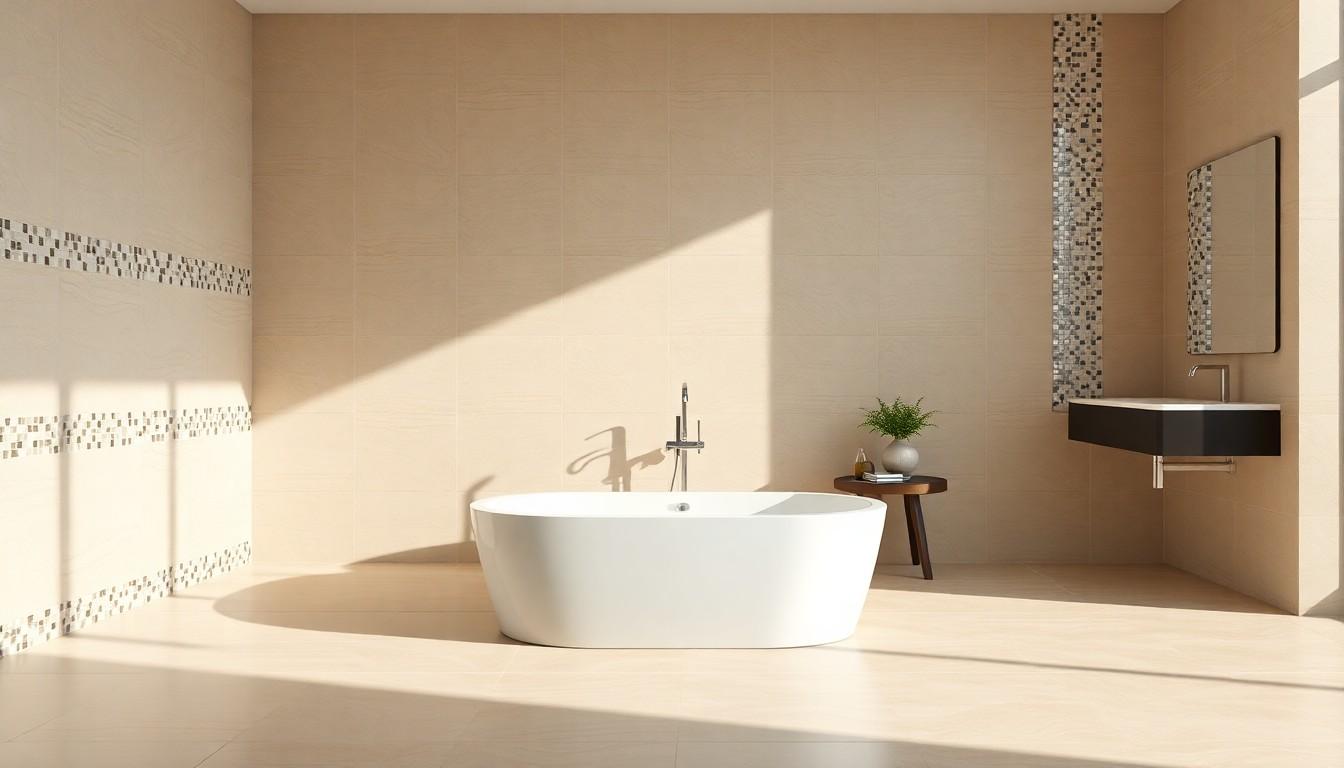
Bathroom floor tiles come in numerous styles and designs to match your aesthetic preferences. From classic patterns to modern innovations, the right floor tiles can transform your bathroom into a stylish sanctuary that reflects your personal taste.
Large Format Tiles
Large format tiles create a sleek, contemporary look in bathrooms with fewer grout lines. These expansive tiles, typically measuring 600×600mm or larger, make small bathrooms appear more spacious by creating an uninterrupted visual flow. The minimal grout lines also mean less cleaning and maintenance over time. Large format tiles in neutral tones like beige, white, or grey establish a calm foundation that complements various décor styles while offering excellent durability for high-traffic bathroom floors.
Mosaic and Patterned Tiles
Mosaic and patterned tiles add character and visual interest to bathroom floors. Geometric patterns, including classic checkerboard designs in black and white, remain consistently popular choices for bathrooms of any size. Moroccan-inspired tiles featuring intricate star and cross patterns bring warmth and an artisanal feel to your space, creating a calming, spa-like atmosphere. Art Deco tiles with bold designs and luxurious motifs add a touch of sophistication and vintage glamour. Patterned tiles work particularly well as feature areas or to zone specific parts of the bathroom.
Wood-Effect Tiles
Wood-effect tiles offer the warm, natural appearance of timber with the practicality of porcelain or ceramic. These tiles replicate various wood species and finishes, from light oak to dark walnut, providing the perfect balance between aesthetics and functionality. Unlike real wood, these tiles withstand moisture without warping, making them ideal for bathroom environments. Wood-effect tiles in plank formats (such as 1200×200mm) create an authentic timber floor appearance while offering superior water resistance and easier maintenance than natural wood. They pair beautifully with both traditional and contemporary bathroom fixtures.
Textured Finishes
Textured floor tiles add depth, dimension and safety to bathroom floors. Tiles with anti-slip finishes provide crucial traction in wet areas, reducing the risk of accidents. Natural stone-effect tiles with subtle texture variations mimic the look of limestone, slate or travertine while offering better maintenance properties. Matt finishes have gained popularity over glossy options for bathroom floors as they show fewer water marks and footprints. Textured hexagonal tiles combine practical grip with contemporary style, creating visual interest through their distinctive shape rather than just colour or pattern.
Installation Considerations
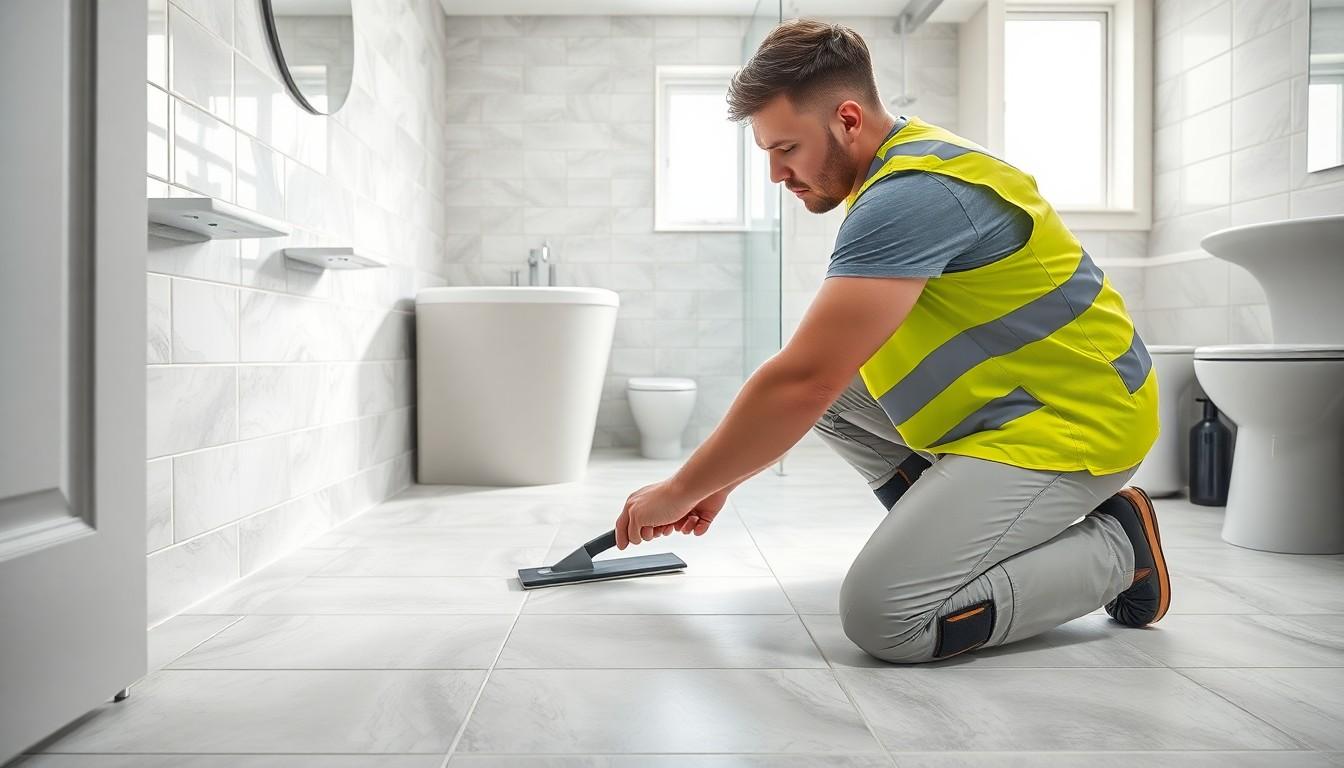
Proper installation of bathroom floor tiles ensures longevity, functionality, and aesthetic appeal. Following the right procedures during installation saves time and money while preventing future problems like cracked tiles or water damage.
Surface Preparation
Surface preparation forms the foundation for successful tile installation. Clean the surface thoroughly, removing all traces of wax, soap scum, and grease that might prevent proper adhesion. Repair any damaged areas, fill cracks, and level uneven spots before proceeding with tile installation.
For installations over existing tiles, inspect them carefully for damage. Replace cracked or dented tiles, then clean and sand the surface until it feels rough to the touch. Apply a primer to increase porosity, creating a better bonding surface for the thin-set adhesive.
When starting with a fresh installation, remove all existing flooring materials completely. Check that your subfloor meets these requirements:
- Uniform thickness throughout
- Completely dry with no moisture issues
- Free from adhesive residue
- Level within industry standards
- Structurally sound with no flexing
Layout and Measurement
Accurate layout and measurement create professional-looking results. Mark the center point of each wall and snap chalk lines between opposing center points to create a grid. Check these lines carefully with a carpenter’s square to ensure they intersect at perfect right angles.
Place a row of loose tiles along the center lines without adhesive to test your layout. Use tile spacers between each tile to maintain consistent grout joints. This dry run helps identify potential issues before permanent installation and allows adjustments to avoid awkward cuts around edges.
Underfloor Heating Compatibility
Bathroom floor tiles pair excellently with underfloor heating systems, offering efficient heat conductivity. Porcelain and ceramic tiles transfer and retain heat effectively, making them energy-efficient options for heated floors.
When installing tiles over underfloor heating:
- Use flexible adhesives and grouts specifically designed for heated floors
- Follow the heating system manufacturer’s guidelines for maximum temperature settings
- Install an uncoupling membrane between the heating system and tiles to prevent cracking
- Allow proper curing time before activating the heating system (typically 7-14 days)
Electric underfloor heating mats work particularly well with tile installations, adding only minimal height to your floor while providing comfort during colder months.
DIY vs Professional Installation
Tiling a bathroom floor presents different challenges depending on your experience level. DIY installation can save £20-£40 per square metre in labour costs but requires specific skills and tools.
Consider professional installation if:
- Your bathroom has complex layouts or requires numerous cuts
- The subfloor needs significant preparation or levelling
- You’re installing expensive materials like natural stone
- You have limited time or physical ability for the project
A professional tiler brings experience with waterproofing techniques and can complete the job more quickly, typically finishing a standard bathroom in 1-2 days compared to 3-4 days for most DIYers.
Essential Tools and Materials
Gathering the right tools and materials before starting ensures a smooth installation process. The essential items include:
Tools:
- Tile cutter or wet saw for precise cuts
- Notched trowel for applying adhesive
- Rubber mallet for setting tiles
- Spirit level for checking flatness
- Tile spacers for consistent grout joints
- Grout float for applying grout
- Sponges and buckets for cleanup
Materials:
- Tiles with 10-15% extra for cuts and breakage
- Tile adhesive appropriate for your tile type and subfloor
- Waterproof membrane for wet areas
- Grout with mould-resistant properties
- Silicone sealant for edges and corners
- Primer for preparing porous surfaces
Calculate materials carefully based on your bathroom measurements. For adhesive and grout, follow manufacturer guidelines for coverage rates—typically 3-5kg of adhesive per square metre depending on tile size and trowel notch depth.
Cleaning and Maintenance Tips
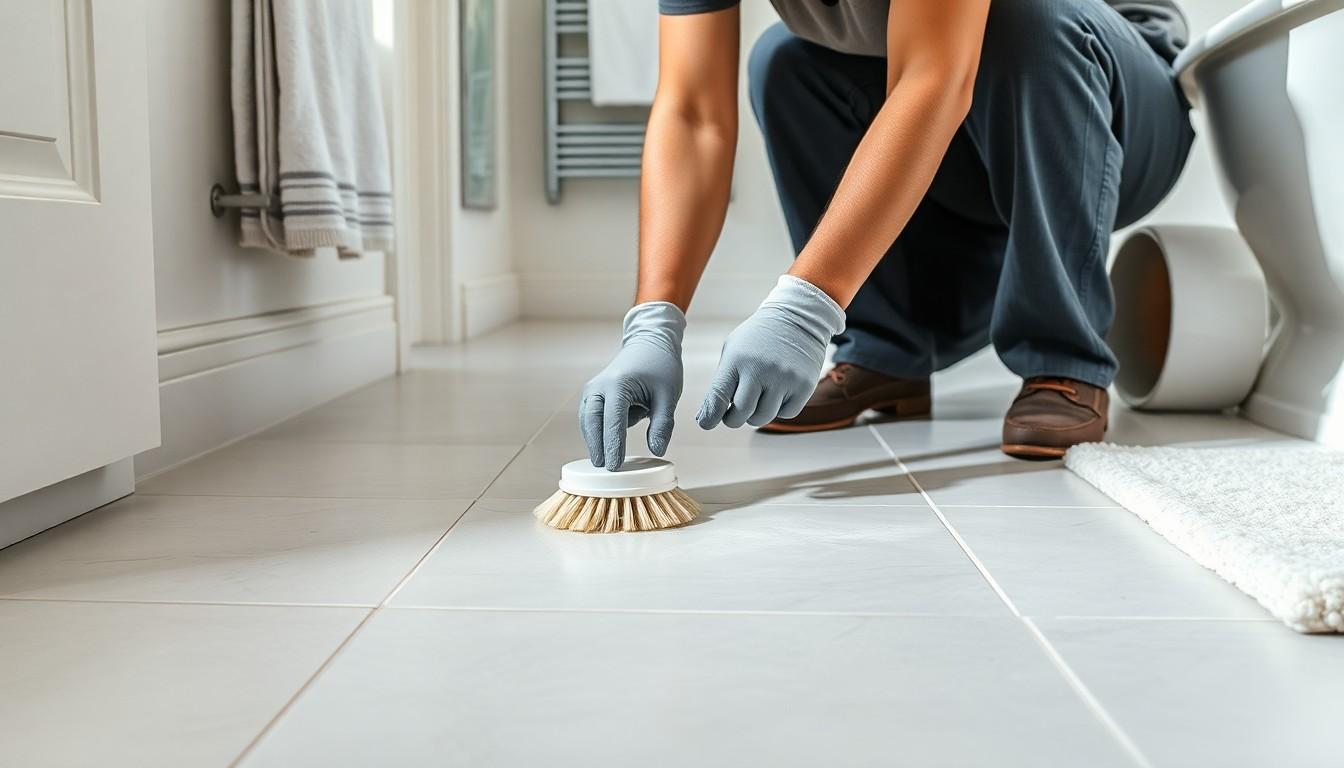
Proper care of bathroom floor tiles preserves their appearance and extends their lifespan. Regular maintenance prevents damage and keeps your bathroom looking fresh and hygienic for years to come.
Daily Care Routine
Bathroom floor tiles benefit from consistent cleaning to prevent buildup of soap scum, mildew, and grime. Sweep or vacuum your bathroom floor at least twice weekly to remove dirt and debris that can scratch tile surfaces. After showering, wipe down wet areas with a squeegee or towel to prevent water spots and mineral deposits.
For weekly cleaning, mix a mild detergent with warm water and mop the entire floor surface. Harsh chemicals damage tile finishes, so stick to gentle cleaners appropriate for your tile material. For ceramic and porcelain tiles, all-purpose cleaners, dish soap, or vinegar solutions work effectively.
Keep in mind that different tile materials require specific care:
- Ceramic/porcelain: Clean with vinegar solutions or mild detergents
- Natural stone (marble, granite): Avoid acidic cleaners like vinegar or ammonia as they cause discoloration
- Vinyl tiles: Wipe with a damp mop and gentle cleaner
An eco-friendly option combines vinegar and baking soda for effective cleaning on suitable tile types. Always dry floor surfaces thoroughly after cleaning to prevent water damage and slip hazards.
Dealing with Grout Issues
Grout lines between tiles often become discoloured or damaged over time. Clean grout regularly using a soft brush and a mixture of baking soda and water to prevent staining. For stubborn stains, apply a paste of baking soda and water, let it sit for 10 minutes, then scrub gently with a toothbrush.
Sealing grout every 6-12 months creates a protective barrier against moisture and stains. Apply sealer with a small brush, working in sections and wiping away excess before it dries. For severely stained or damaged grout, regrouting offers a fresh appearance without replacing the entire floor.
Signs that indicate your grout needs attention include:
- Cracking or crumbling sections
- Dark discolouration that doesn’t respond to cleaning
- Soft texture when touched
- Visible mould or mildew growth
When regrouting, remove old grout carefully using a grout removal tool, clean thoroughly, and apply new grout following the manufacturer’s instructions. Proper application ensures your new grout remains intact and resistant to moisture.
Extending Tile Lifespan
Bathroom floor tiles last longer with preventative maintenance and proper care. Place bath mats in high-traffic areas to reduce wear and protect against scratches. Use furniture pads under any cabinets or storage units that rest on the floor to prevent damage when moved.
Address spills immediately, particularly acidic substances like shampoo or cleaning products that can etch or stain tile surfaces. Avoid dragging heavy objects across the floor, and lift items instead of sliding them.
For long-term protection:
- Reseal natural stone tiles annually to prevent moisture absorption
- Check and repair damaged grout promptly to prevent water seepage
- Use microfibre cloths rather than abrasive scrubbers when cleaning
- Maintain proper ventilation to reduce humidity levels that contribute to mould growth
Regular inspections help identify small issues before they become major problems. Check for loose tiles, grout deterioration, or signs of water damage underneath tiles, particularly around toilet bases and shower areas. Early intervention saves both time and money on extensive repairs later.
Current Trends in Bathroom Floor Tiles
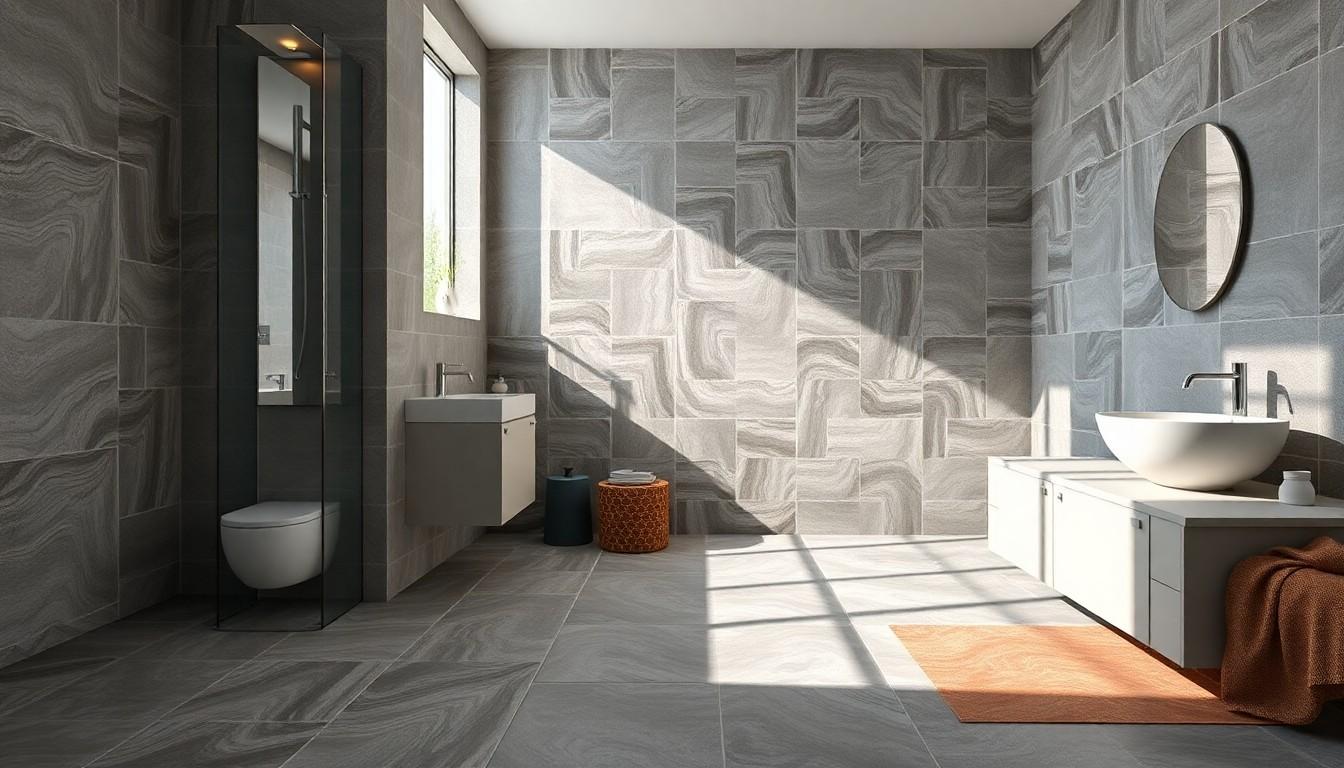
Bathroom floor tile trends are constantly evolving, reflecting both technological advancements and changing design preferences. The latest innovations focus on sustainability, modern colour schemes, and creative shapes that transform ordinary bathrooms into distinctive spaces.
Sustainable and Eco-Friendly Options
Sustainable bathroom tiles are dominating the 2025 market with options that reduce environmental impact without sacrificing style. Recycled material tiles made from repurposed glass, ceramics, and reclaimed wood offer vibrant colours and unique textures while minimising waste. These eco-conscious options create striking visual impact while supporting environmental preservation.
Natural stone tiles including limestone, travertine, and slate remain popular for their timeless beauty and minimal ecological footprint. Many manufacturers now produce synthetic tiles that convincingly mimic natural materials but with significantly reduced environmental impact during production. These alternatives provide the aesthetic appeal of natural materials with improved sustainability credentials.
Health-conscious homeowners are increasingly selecting tiles free from harmful chemicals, which contribute to better indoor air quality. These non-toxic options support healthier living environments while maintaining high design standards, making them ideal for family bathrooms where air quality concerns are paramount choosing a reputable retailer is vital.
Contemporary Colour Palettes
Grey continues to dominate bathroom floor tile choices, offering versatility that complements various design styles. From light ash tones to deep charcoals, grey tiles create sophisticated foundations that pair effortlessly with both cool and warm accent colours. This neutrality makes them perfect for bathrooms where fixtures or accessories might change over time.
Earthy, organic tones are gaining significant traction, with terracotta, clay, and warm beige creating inviting, grounded spaces. These colours connect interior spaces with natural environments, offering a sense of calm and continuity with the outdoors. Muted greens and blues are also rising in popularity, introducing subtle colour without overwhelming the space.
Black and white combinations remain timeless choices, with modern interpretations featuring matte finishes or subtle texture variations. Contemporary bathrooms often feature high-contrast designs using these classic colours in unexpected patterns or layouts, creating visual interest while maintaining a clean aesthetic.
Innovative Shapes and Sizes
Large-format tiles, measuring 60×60cm or larger, are increasingly popular for creating seamless, expansive-looking bathroom floors. These substantial tiles minimise grout lines, producing a cleaner, more continuous appearance that makes small bathrooms appear larger and more luxurious. Their simplified installation pattern creates a modern, uncluttered foundation.
Hexagonal and other geometric shapes offer creative alternatives to traditional square or rectangular tiles. These distinctive shapes create visual interest and allow for unique layout patterns that become focal points in the bathroom design. Combining different shapes or creating transitions between flooring areas adds architectural detail without additional decorative elements.
Three-dimensional and textured tiles add tactile interest to bathroom floors while improving slip resistance. Subtle raised patterns, ribbed surfaces, or intentionally uneven finishes create depth and dimension that catches light differently throughout the day. These textured options enhance safety while contributing to the overall design aesthetic with their sculptural qualities.
Conclusion
Your bathroom floor tiles do more than just cover a surface. They’re an investment in your home’s style durability and function. By selecting the right material texture and design you’ll create a space that withstands moisture while expressing your personal aesthetic.
Remember that proper installation and regular maintenance are key to ensuring your tiles stand the test of time. Whether you opt for porcelain’s durability natural stone’s elegance or vinyl’s practicality your choice should balance beauty with practicality.
With thoughtful selection and care your bathroom floor tiles will serve as the foundation for a space that remains beautiful functional and inviting for years to come.
Frequently Asked Questions
What are the best types of tiles for bathroom floors?
Porcelain tiles are considered the most durable option for bathroom floors due to their low water absorption rate and resistance to stains and damage. Ceramic tiles offer good water resistance at a lower price point. Natural stone adds elegance but requires more maintenance, while luxury vinyl tiles provide a practical, comfortable alternative that can mimic natural materials while offering excellent moisture resistance.
How do I choose slip-resistant bathroom floor tiles?
Look for tiles with anti-slip ratings (R9-R13, with R11 or higher recommended for bathrooms). Choose textured surfaces rather than polished finishes, especially for wet areas. Small mosaic tiles provide more grout lines, creating additional grip. Consider specially designed slip-resistant tiles with microscopic textured surfaces that maintain traction when wet while still being easy to clean.
Are large format tiles suitable for small bathrooms?
Yes, large format tiles can actually make small bathrooms appear more spacious. They create fewer grout lines, resulting in a sleek, continuous look that visually expands the space. However, proper installation is crucial as the fewer grout lines mean less forgiveness for uneven surfaces. Consider 30×60cm or 60×60cm tiles for smaller bathrooms to achieve this spacious effect.
How do I maintain natural stone bathroom floor tiles?
Natural stone requires more maintenance than porcelain or ceramic tiles. Clean regularly with pH-neutral cleaners specifically designed for natural stone. Avoid acidic or abrasive cleaners that can damage the surface. Apply a quality stone sealer every 6-12 months to protect against moisture and stains. Wipe up spills promptly and use bath mats to reduce water exposure in high-traffic areas.
What are the current trends in bathroom floor tiles?
Current bathroom tile trends include sustainable and eco-friendly options made from recycled materials, natural stone or convincing synthetic alternatives, and large-format tiles that minimise grout lines. Contemporary colour palettes favour grey tones, earthy neutrals, and classic black-and-white combinations. Geometric patterns and innovative shapes like hexagons are popular, along with textured finishes that enhance safety while adding visual interest.
Can bathroom floor tiles be installed over existing flooring?
Yes, in many cases tiles can be installed over existing flooring, saving time and money on demolition. However, the existing floor must be stable, level, and free of damage. Some surfaces may require special preparation, such as applying a primer or levelling compound. The additional height of new tiles should be considered for door clearances and transitions to other rooms. Professional assessment is recommended for the best results.
Are floor tiles compatible with underfloor heating?
Most ceramic and porcelain tiles are excellent conductors of heat, making them ideal for use with underfloor heating systems. Natural stone tiles also work well, though some dense varieties may take longer to warm up. Ensure the heating system is appropriate for your chosen tiles and professionally installed. The combination provides efficient heat distribution and comfortable, warm floors even in the coldest months.
How do I prevent grout discolouration in bathroom floor tiles?
Prevent grout discolouration by applying a quality grout sealer after installation and reapplying annually. Clean tiles regularly with a pH-neutral cleaner to prevent buildup of soap scum and mildew. Use a soft brush to clean grout lines weekly. For stubborn stains, make a paste of baking soda and water, apply to grout lines, leave for a few hours, then scrub gently and rinse thoroughly.
What’s the difference between porcelain and ceramic bathroom tiles?
Porcelain tiles have lower water absorption (less than 0.5%) compared to ceramic tiles (0.5-3%), making them more suitable for wet areas. Porcelain is denser, harder, and more durable but typically more expensive. Ceramic tiles offer more design variety and are easier to cut and install. Both provide good water resistance, but porcelain’s superior water resistance makes it ideal for bathroom floors that experience frequent moisture.
How much should I budget for bathroom floor tiles?
Budget varies widely based on material, quality, and design complexity. Basic ceramic tiles start around £15-£30 per square metre, while porcelain ranges from £20-£60. Natural stone tiles can cost £40-£100+ per square metre. Luxury vinyl tiles fall between £20-£50. Remember to budget for additional materials (adhesive, grout, sealer) and installation costs, which can add 50-100% to material costs if professionally installed.


